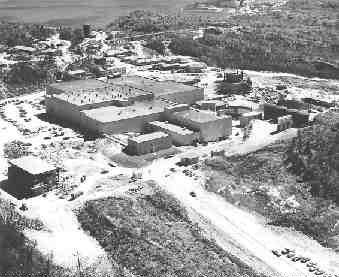In 1949, Arthur Stollery (1914-1994) was working for Franc Joubin (1911-1997) at the Camray Uranium prospect, north of Sault Ste. Marie, Ont. Joubin asked him to examine the surface showing on the Long Twp. property, north of Algoma, Ont., which, at the time, was staked by Carl Gunterman.
Stollery examined the claims, and he too determined that the readings on his geiger counter were due to surface leaching and not leaching from significant deposits at depth.
About three or four years later, when Joubin, backed by grubstaker John Hirshhorn (1900-1981), restaked what was then called the Peach property, diamond drilling intersected economical grades of uranium where the continuous conglomerates were not leached or oxidized at depth.
Joubin asked Stollery to manage the property but, in his excitement, mentioned the potential for similar deposits farther north. Stollery declined the offer and Don Smith was hired. It’s obvious Stollery figured he could stake his own claim and might capitalize on it . . . and capitalize he did.
A little detective work soon led him to Quirke Lake, about 10 miles northwest of Elliot Lake, where the Preston East Dome crews were busy secretly staking claims on behalf of Joubin and Hirshhorn. Stollery, with partners Fred Jowsey, Jim Kenmey, a bushman, several canoes and fists full of mining licences, registered 80 claims, mostly over the waters of Quirke Lake. Stollery was essentially staking the downdip extension of Rio Algom’s Quirke Lake deposit, and, at the time, I was camped to the east, along the north belt of the “Big Z” sedimentary contact.
Reserves at the Elliot Lake and Quirke Lake deposits grew steadily, and Stollery spent six months walking up and down Bay Street in Toronto, with his claims under his arm, looking for investors. He eventually ended up in Hirshhorn’s office, but the two men did not see eye-to-eye and, after a harsh exchange of words one day, Stollery left without a deal.
After a few more failed attempts, Stollery turned to Bay Street financier Steven Roman (1921-1988). According to Joubin, Roman paid Stollery $30,000 and issued him 500,000 shares of Consolidated Denison Mines. Stollery’s claims turned to be the largest discovery, and Consolidated Denison would peak at $80 per share.
Roman and Stollery became business partners, with Roman as president of the company and Stollery as vice-president. For 12 years they worked together, though their relationship was strained, to say the least.
In time, Joubin tried to instigate a Dension takeover, but Hirshhorn sabotaged any possible deal. Joubin was nonetheless able to help Ralph Benner, a Denison geologist, locate the westerly edge of the Denison deposit that was plunging to the southeast.
However, before Stollery staked the area that would eventually become the prolific Denison uranium mine, he was already a success.
At Queen’s University, he was among Canada’s top amateur golfers and captain of the school’s hockey and football teams. As quarterback for Queen’s Golden Gaels football team, Stollery captured two intercollegiate titles. He graduated with a degree in mining engineering in 1939 and joined the Royal Canadian Air Force (RCAF) as a pilot. While with the air force, Stollery was a quarterback with the Hamilton RCAF Flying Wildcats, who played in the Ontario Rugby Football Union (precursor to the Canadian Football League). The Wildcats won the Grey Cup in 1943.
Stollery’s pedigree also served him well. His father, Frank, was a prominent Toronto businessman and owner of Stollery’s, a clothing store at the intersection of Bloor and Yonge Streets.
After mining made him wealthy, Stollery bought a large property northeast of Toronto, where he would raise champion Aberdeen Angus cattle and race horses. One of his horses, “Kennedy Road,” won the prestigious Queens Plate in 1971. Eventually, Stollery became bored with horse-racing pursuits and, in 1992, began to build a golf course on his property. He passed away in 1994, but in 1995 the Angus Glen golf course opened and was voted best new course that year by Golf Digest magazine.
Next week: Joe Hirshhorn
The author, a retired mining engineer, resides in Barrie, Ont.


Be the first to comment on "Stollery’s legacy"